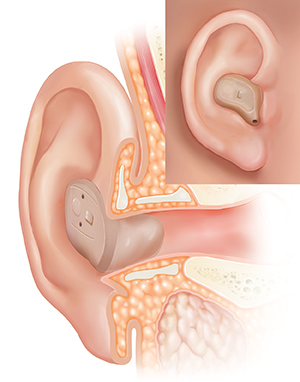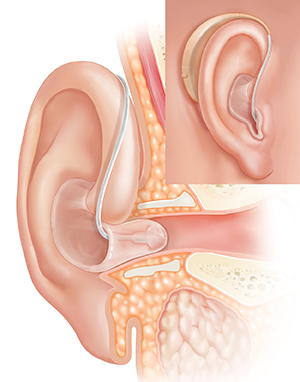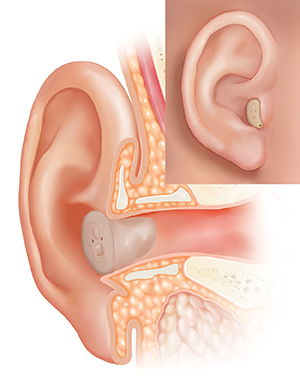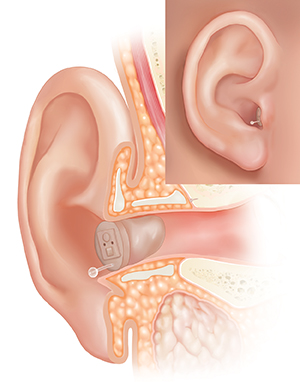Hearing Aids
What are hearing aids?
Hearing aids can help improve hearing and speech for people with hearing loss. Hearing
aids are electronic, battery-operated devices that make sounds louder. A microphone
receives the sound as sound waves. The sound waves are then changed into electrical
signals.
Hearing aids are very helpful if you have hearing loss in the inner ear due to damaged
hair cells or a damaged hearing nerve (called sensorineural hearing loss). This type
of hearing loss can be caused by:
What are the different types of hearing aids?
The type of hearing aid recommended for you depends on your home and work activities,
physical ability, health condition, and personal preference. There are 4 basic types
of hearing aids. Talk with your healthcare provider for more information on each of
these types:
In-the-ear (ITE) hearing aids
These hearing aids come in plastic cases that fit in the outer ear. They are generally
used for mild to severe hearing loss. ITE hearing aids can also be used with other
hearing devices. These include the telecoil, a device used to improve sound during
phone calls. But the ITE's small size can make it hard to make adjustments. The ITE
can also be damaged by ear wax and drainage.

Behind-the-ear (BTE) hearing aids
These hearing aids are worn behind the ear. This type of hearing aid is in a case.
It connects to a plastic ear mold inside the outer ear. These are generally used for
mild to severe hearing loss. Poorly fitted BTE hearing aids can cause an annoying
whistling sound (feedback) in the ear. But all hearing aids can have feedback.

Canal aids
Canal aids fit directly in the ear canal. They come in 2 sizes: in-the-canal (ITC)
aid and completely-in-canal (CIC) aid. Canal aids are customized to fit the size and
shape of the person's ear canal. They are generally used for mild to moderate hearing
loss. Their small size can make them hard to remove and adjust. They can also be damaged
by ear wax and drainage.


Body aids
Body aids are attached to a belt or pocket. They are connected to the ear with a wire.
They are mainly used only for profound hearing loss. Or if the other types of hearing
aids can't be used.
Who can be helped by hearing aids?
Anyone who has hearing loss that may be improved with hearing aids can benefit from
these devices. The type of hearing aid recommended may depend on several factors,
including:
-
The shape of the outer ear (abnormally formed ears may not accommodate behind-the-ear
hearing aids)
-
Depth or length of the ear canal (ears that are too shallow may not accommodate in-the-ear
hearing aids)
-
The type and severity of hearing loss
-
Your ability to remove and insert hearing aids
-
The amount of wax buildup in the ear (too much wax or moisture may prevent use of
in-the-ear hearing aids)
-
Ears that need drainage may not be able to use certain hearing aid models
Wearing a hearing aid
Once the hearing aids have been fitted for your ears, start slowly wearing the hearing
aid. Hearing aids don't restore normal hearing. So, it may take time to get used to
the different sounds sent by the device. Follow these tips when first wearing a hearing
aid:
-
Be patient. Give yourself time to get used to the hearing aid and the sound it makes.
-
Start using it in quiet places. Slowly build up to noisier places.
-
Experiment with where and when the hearing aid works best for you.
-
Keep a list of any questions and concerns you have. Bring those to your follow-up
exam.
Taking care of hearing aids
Hearing aids need to be kept dry. Cleaning methods vary depending on the style and
shape. Other tips for taking care of hearing aids include:
-
Keep the hearing aids away from heat and moisture.
-
Store batteries in a safe place. Keep them out of the reach of children and pets.
-
Replace batteries on a regular basis.
-
Don't use hairspray and other hair products when the hearing aid is in place.
-
Turn off hearing aids when they are not in use.
What to ask when buying a hearing aid
You will need a medical exam before getting hearing aids. You can be evaluated for
hearing aids from a specialist, such as an ear, nose, and throat healthcare provider
(otolaryngologist); or an audiologist, who specializes in evaluating and managing
hearing and balance problems. These specialists can assist you in getting hearing
aids. You can also buy 1 from an independent company. Styles and prices vary. Your
insurance company may or may not cover part or all of the cost of your hearing aids.
Ask these questions when considering getting hearing aids:
-
Can my hearing loss be improved with medical or surgical interventions?
-
Which design will work best for my type of hearing loss?
-
May I test the hearing aids for a certain time?
-
How much do hearing aids cost?
-
Do the hearing aids have a warranty? Does it cover maintenance and repairs?
-
Can my audiologist or otolaryngologist make adjustments and repairs?
-
Can any other technology devices that provide assistance be used with the hearing
aids?
Over-the-counter (OTC) hearing aids
The FDA has created a new category of OTC hearing aids for people ages 18 and older
with mild to moderate hearing loss. People can now purchase some types of hearing
aids without seeing a healthcare provider. Talk with your healthcare provider if you
have questions about the different hearing devices available to you.